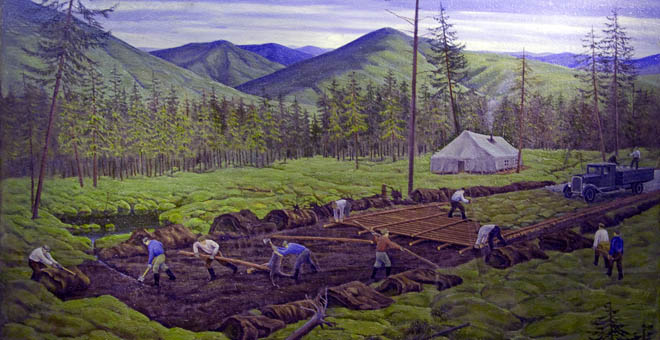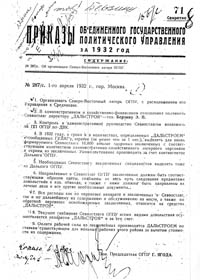|
Dalstroy's first year
|

Initial priorities
Constructing the harbour in Nagaevo Bay was one of the top three priorities. The work was difficult as the coast was steep and the prisoners did not have any modern equipment to facilitate their task.
The second priority was to establish the town of Magadan next to the little Magadanka River. The river does not run into Nagaevo Bay. The two are therefore quite separate even if they seem to be in practically the same place. The houses were built of timber from the surrounding forests. The work was really hard and very slow. The prisoners did not even have time to build huts for themselves that first summer.
Top priority was given to road building. The road was to go north to the goldfields. And by the following summer it was to reach all the way to Seimchan, some 900 km to the north. Kolyma is one of the most difficultly accessible areas on the globe and, even with tremendous efforts, they did not reach Seimchan until the summer of 1937.

The number of prisoners has been intensely debated but recent research seems to show that, though incredibly high, the figure was much lower than first thought. There were probably just under 12,000 prisoners at the end of the first year. But that is the number of men who could be sent out to work, in other words those who were still alive.
Building road was really hard work. Kolyma which corresponds to today’s Magadan Region is covered with permafrost and taiga. Taiga is the primeval forest which covers most of Russia. It is full of swamps as the water cannot penetrate the ever frozen ground.
The summer is short and intense. I have myself experienced temperatures of over 30 C in the shade. And there are swarms of midges all around. A real hell. The prisoners lived in tents in the swamps. To build roads, they first had to cut a path through the forest and then fell even more trees as they needed their trunks to keep the roadway above the permafrost. If this was not done, the road would sink into the ice during the summer and disappear within a few years.
The first winter and the tales they told
The winter of 1932/33 was exceptionally hard. The prisoners had not yet built wooden huts for themselves and they had to brave the winter in tents, even without the reindeer skin sleeping bags used by the natives. One tale tells of how only half the prisoners survived until the following summer.
Even a normal winter is very hard in Kolyma. In the interior, the winter begins as early as August. The thaw does not come until late May. In Magadan, on the coast, it is much milder. Nagaevo Bay freezes up in December. Not until April can supplies be brought in without the help of icebreakers.
Snowstorms can come without warning. Even today people are overcome by the snow and perish in what they call the "purga". In those days, for the undernourished prisoners without reliable weather forecasts, they must have been deadly. There are also frequent whiteouts where you lose all sense of direction after walking just a few yards. Under conditions like these, no one went out unless they could depend on a life line to find the way back to their huts. Many simply did not return after going out for firewood. Their bodies were not found until the snow melted the following spring.


Gold production reached a modest 500 kg of pure gold in 1932. The ring road through the gold district was not completed. It must have been difficult for Berzin to explain it all to his masters.
Next: The Berzin years